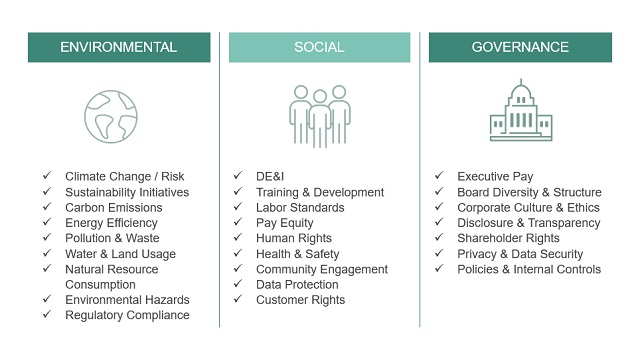- within Insurance, Wealth Management and Tax topic(s)
What is ESG?
Environmental, Social and Governance, or ESG, are the three pillars of performance by which a business' impact on society and the environment, can be evaluated. ESG, in a business context, is about a company's culture, operations and business model. More specifically, it is about how a company, and its products and services contribute to greener, socially-just, and more transparent world. By understanding a company's strategy and successes in each pillar, stakeholders, such as investors, employees, consumers and governments/regulators can decide how they interact with an organization.
Investors, activists and regulators are demanding proactive, employee engagement, community-level commitments and accountability to address important sustainable topics such as climate change, social injustice, and inequality. Accordingly, ESG is one of the defining challenges for businesses across the globe for the 21st century.
The "definition" of ESG differs from person to person, firm to firm, industry to industry as well as county to country. Remedies, targets and goals will also differ. However, taking a proactive approach to addressing ESG topics is consistent for all people, firms and industries.
What Are the ESG Factors?
The definition of "E" in ESG:
The Environment component of ESG covers how the business interacts with the natural environment, the environmental impacts of its operations, and the actions the company takes to mitigate the negative effects, such as climate change, resource depletion, waste, pollution, deforestation and biodiversity, to name a few examples.
Businesses typically commence their environmental journey by measuring or evaluating their "carbon footprint". This includes direct impacts, such as greenhouse gas (GHG) emissions, raw material use, land use, water consumption, pollution and waste creation. The assessment must also include indirect effects that occur upstream or downstream from the business, such as GHG emissions from product use, the company's supply chain activities, as well as the impact from the company's operations
The definition of "S" in ESG:
The Social component of ESG covers how an organization's activities affect people, including its workforce, customers, local communities as well as those who work in its extended supply chain.
The social element covers an extensive range of factors, including diversity and inclusion, equality, safe working conditions, fair compensation, workforce health and wellbeing; and guarding against modern slavery and child labour. It also considers an organization's responsibility to support society proactively through initiatives such as education programs and employee development, as well as local community support and engagement.
The definition of "G" in ESG:
The Governance component of ESG relates to the policies, structures and procedures by which an organization is operated. Governance includes decision-making processes, executive compensation, board oversight and composition, transparency and disclosures and anti-corruption measures.
Governance also incorporates the organization's compliance with regulations and its risk management framework, which include the risks arising from ESG factors, in addition to the traditional risk stripes.
Originally Published 31 May 2022
The content of this article is intended to provide a general guide to the subject matter. Specialist advice should be sought about your specific circumstances.




